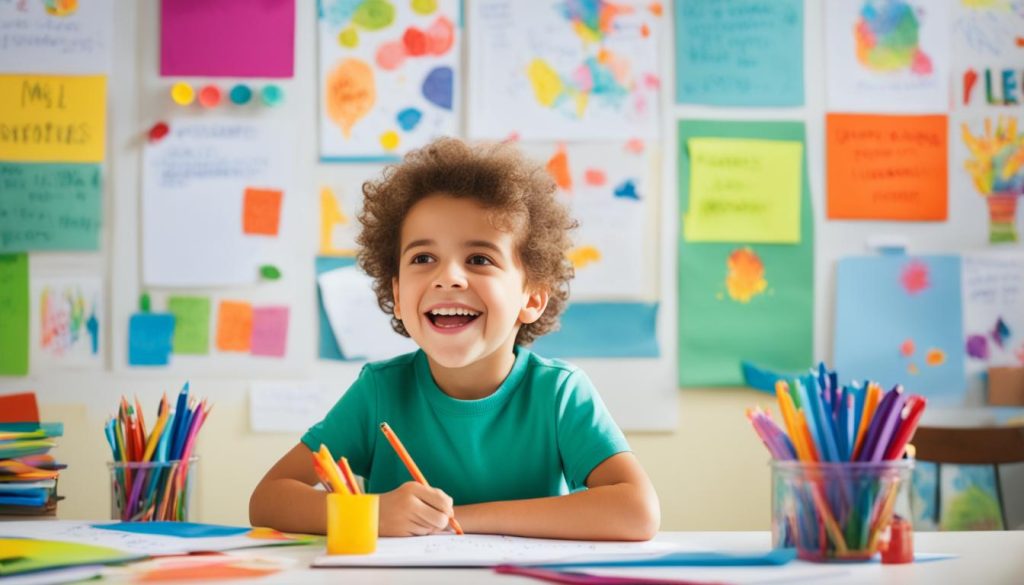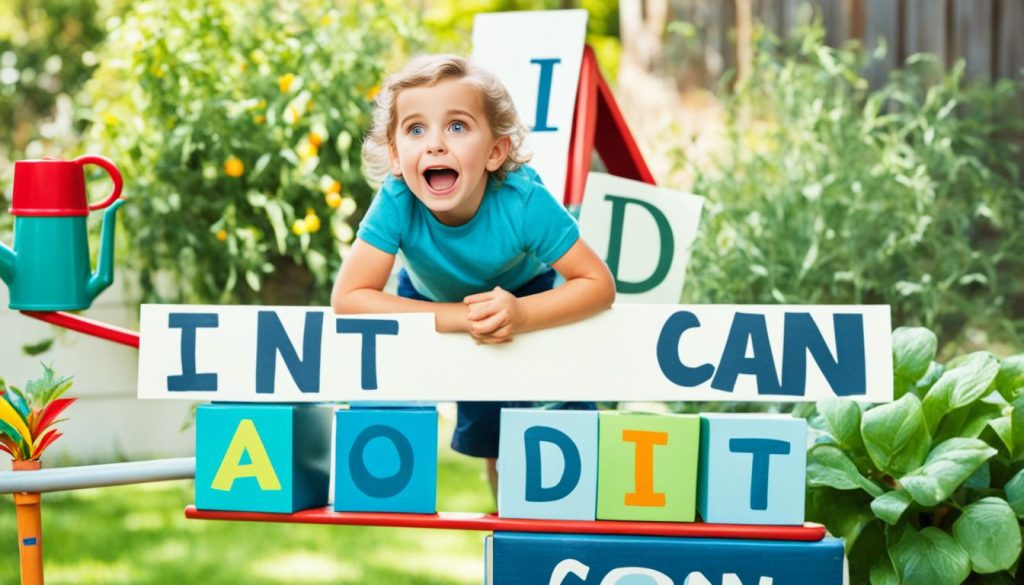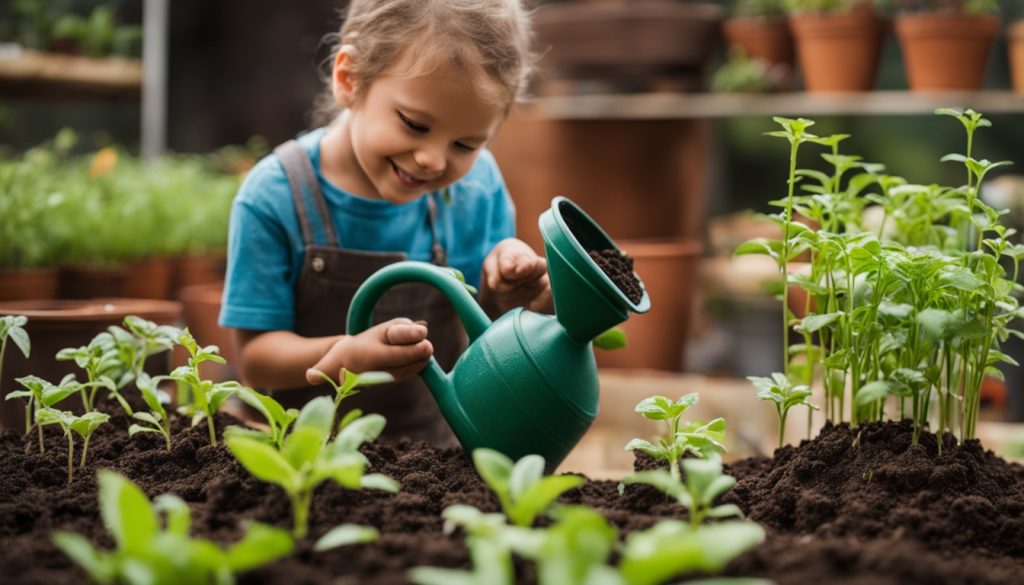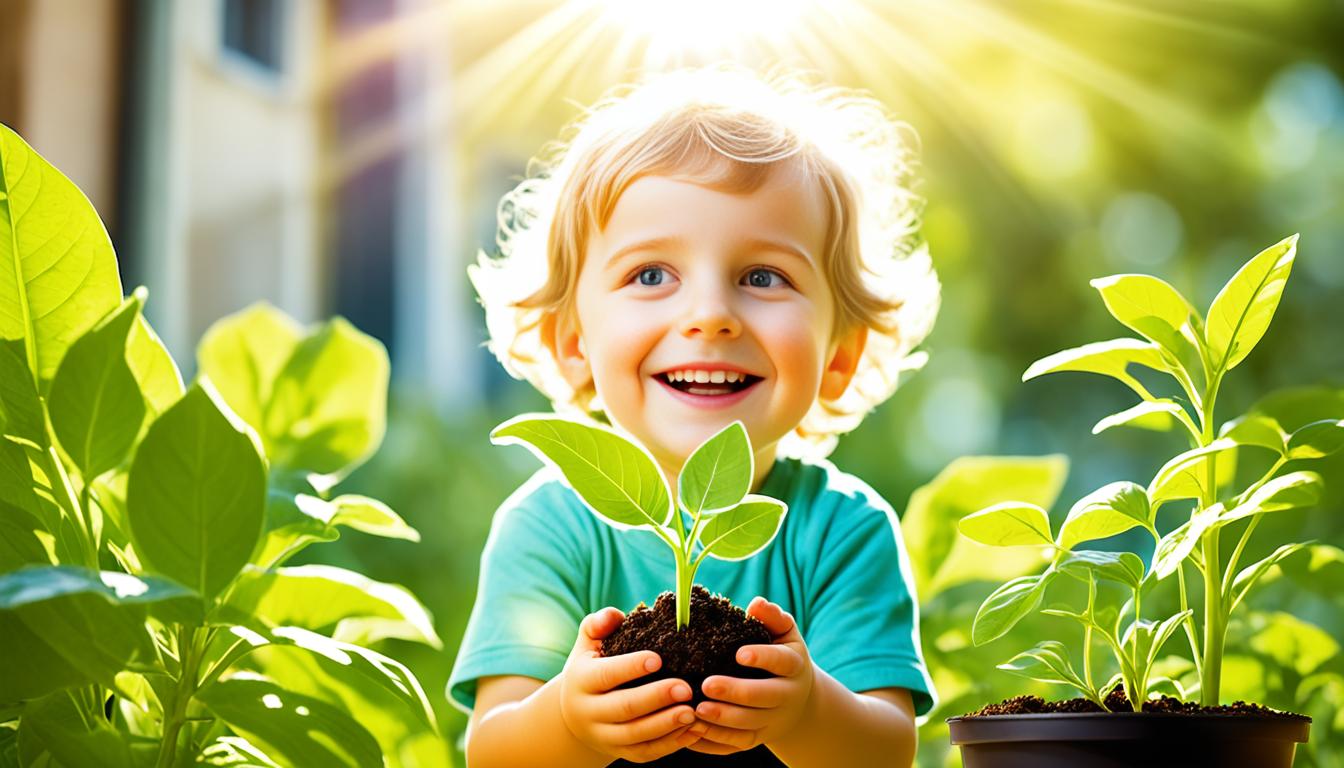Have you seen the excitement in your child’s eyes when they understand something hard or learn a new skill? It’s a special moment, filled with their belief in their ability to get better and grow. As parents, helping them believe in their potential is a powerful gift. By using “yet,” we open up their world and help them bounce back from challenges.
Carol Dweck’s research on growth mindset shows us that kids who think they can get better with effort and practice are more likely to tackle challenges. This is different from a fixed mindset, where abilities don’t change. With a growth mindset, your child can do better in school, feel more resilient, and love learning more.
Picture a world where your child sees every challenge as a chance to grow. By using positive parenting, setting clear boundaries, and boosting their self-esteem, you help them thrive. Talking with your child and guiding them through their milestones helps them reach their full potential.
Teaching your child to say “I can’t do this… yet” changes how they face challenges. It boosts their self-confidence and shows them that hard work and trying again leads to success. This mindset helps them not just in school, but in life, making them resilient and curious.
Key Takeaways
- A growth mindset is the belief that abilities can be expanded with effort and practice.
- Children with a growth mindset are better at bouncing back from challenges.
- Encouraging a growth mindset involves praising effort over results.
- Positive parenting strategies help in setting up an environment where children can thrive.
- Integrating the power of “yet” transforms everyday challenges into growth opportunities.
What is a Growth Mindset?
A growth mindset means believing that you can get smarter and better at things with hard work and learning from your mistakes. This idea helps kids see challenges as chances to grow, not threats. It helps them do better in school and builds their ability to bounce back when things get tough.
Definition and Origins
Carol Dweck, a famous psychologist, came up with the idea of a growth mindset. She found that kids who think they can get better with effort and hard work are more likely to take on new challenges. This is different from a fixed mindset, which says you’re just born smart or talented.

Growth Mindset vs Fixed Mindset
A growth mindset means you can always get better, while a fixed mindset says you’re stuck with what you have. Kids with a fixed mindset might avoid hard tasks to avoid failing. But kids with a growth mindset see challenges as ways to learn and grow. This big difference changes how they do in school and how they feel about themselves.
Importance of a Growth Mindset in Children
Having a growth mindset is super important for kids. It helps them learn and bounce back better. It teaches them to value trying hard over being naturally good at something. This makes them love learning more and keep growing.
It also helps them handle their feelings, get along with others, and grow overall.
Why a Growth Mindset Matters for Kids
Understanding a growth mindset is key for kids. It helps boost their creativity and mental health. This mindset affects their school success and emotional strength, helping them learn for life.
Academic Success
Kids with a growth mindset do better in school. They believe they can get smarter with hard work and smart strategies. This makes them more eager to tackle tough tasks.
When we praise their effort, not just their natural talent, they do even better. They’re more likely to take harder classes and do well across the board.
Emotional Resilience
A growth mindset also helps kids bounce back from setbacks. It teaches them their brains can change and grow. This makes them see mistakes as chances to learn.
By showing them that mistakes are okay, we help reduce their stress and worry. The Greater Good Science Center offers great tips to bring this into your home, helping your child’s mental health.

Preparation for Lifelong Learning
A growth mindset prepares kids for learning their whole lives. It turns challenges into chances to grow and learn. This keeps them motivated from within.
Teaching them how to breathe deeply can also help them handle stress better. This makes them more adaptable and ready to learn from anything. It sets them up for success in school and beyond.
In short, a growth mindset is key for kids’ mental health and creativity. By using these strategies, you can help your kids become resilient and eager learners. They’ll face life’s challenges with confidence and joy.
Emphasizing the Power of “Yet”
Using “yet” in your daily talk can really change how you parent and raise kids. Teaching kids to say “yet” helps them keep going and turns negative thoughts into chances to grow.

Examples of Using “Yet”
Think about the change from “I can’t do this” to “I can’t do this yet.” The “yet” part makes kids think about moving forward and what they can do. For example, if your child says, “I don’t understand this math problem,” help them say, “I don’t understand this math problem yet.” This small change helps them see they can get better with time.
Studies show that teaching kids responsibility gets easier when they know they can get better at things. For instance, when your child finds a new task hard, tell them they’re not there yet but they’ll get it with practice.
Turning Negative Self-Talk into Positive Affirmations
Positive parenting is key in changing how kids see their skills. Instead of letting them focus on the negative, encourage them to use “yet” in their affirmations. For example, if your child is upset about a school task, change their “I’m not good at this” to “I’m not good at this yet.” This helps them bounce back stronger and prepares them for learning and adapting throughout life.
By using “yet,” you give your kids steady and encouraging feedback to tackle challenges. Celebrating their achievements and setting reachable goals helps them grow. It’s important to focus on trying hard, not just being perfect, for positive parenting and raising kids.
Incorporating Growth Mindset in Daily Parenting
Starting a growth mindset in kids starts with what parents do every day. This way, they help with Parent-Child Communication. It also helps in Building Self-Esteem in Children and Fostering Child Independence.

Modeling Behavior
Parents are like role models for their kids. What they do and say shows kids how to handle challenges. Showing a growth mindset means more than just saying nice things. It’s about being resilient, curious, and excited to learn yourself.
Using positive self-talk and not giving up when things get hard is important. This helps with Parent-Child Communication. It also helps kids feel good about themselves and become more independent.
Sharing Personal Challenges and Learning Moments
Talking about your own struggles and what you’ve learned is key. It shows kids it’s okay to face problems and learn from them. This makes them feel safe to talk about their own problems and ask for help.
Talking about how you keep going and what you do to succeed helps kids see the value of effort and hard work. This boosts their self-esteem. It also helps them be more independent as they learn to solve problems on their own.
Use these tips every day to help your child grow a growth mindset. Here are some tips to follow:
- Be Open About Mistakes: Share your own mistakes and what you learned from them.
- Celebrate Effort: Focus on the effort your child puts into tasks rather than the final result.
- Encourage Questions: Create an environment where curiosity is welcomed and encouraged.
- Use Growth Mindset Language: Incorporate phrases like “I can’t do this yet” and “What can I learn from this?”
| Resource | Benefits for Growth Mindset |
|---|---|
| Big Life Journal’s Growth Mindset Parenting Guide | Provides step-by-step tips for integrating growth mindset into daily parenting. |
| Mindsets for Parents: Strategies to Encourage Growth Mindset in Kids by Mary Cay Ricci and Margaret Lee | Offers research-based strategies for developing growth mindset in children. |
| The Gifts of Imperfect Parenting by Brene Brown | Guides on cultivating courage and compassion in children. |
| Backwards Brain Bicycle by Smarter Every Day | Demonstrates how the brain learns and adapts, reinforcing the concept of neuroplasticity. |
Using these resources and methods will help you and your kids develop a growth mindset. This sets the stage for facing life’s challenges with resilience and adaptability.
Effective Praise: Focusing on Effort, Not Intelligence
Positive Parenting relies heavily on effective praise. By focusing on effort, not just intelligence, you help your child develop a growth mindset. This means praising the hard work and strategies they use, not just their natural talent.
Regularly praising their effort can greatly improve their academic performance, self-confidence, and their readiness to tackle challenges.
Examples of Process Praise
Here are some ways to praise your child’s effort:
- “I can see you worked really hard on this math problem, great job!”
- “Your persistence in practicing the piano is really paying off!”
- “You kept trying different strategies until you solved that puzzle, well done!”
This kind of praise focuses on the effort and strategies your child uses, not just the outcome. It encourages them to keep trying, even when things get tough.
The Impact of Praise on Mindset Development
Studies show that praising effort has a big impact on kids. When kids are praised for their hard work, they become more resilient and love learning more.
| Study | Key Findings |
|---|---|
| Carver et al 2022 | Parental praise predicted higher vocabulary and better math skills by age 5. |
| Cimpian et al 2007 | Preschoolers showed more persistence when praised for specific efforts on drawings. |
| Zentall and Morris 2010 | Kindergarteners with process-based praise were more motivated after failure. |
| Gunderson et al 2018 | Specific process-based praise led to higher academic achievement over several years. |
Using Positive Parenting methods like process praise goes well with teaching kids gratitude and managing screen time. Small, consistent efforts can lead to big benefits over time. This helps kids build a strong base for learning throughout their lives.
Challenges as Opportunities for Growth
Facing challenges is key to growing for both kids and parents. Meeting obstacles with a positive attitude turns them into chances for learning and growth. Encouraging kids to take risks and keep trying builds resilience and problem-solving skills for life.
Encouraging Risk-Taking and Persistence
Handling sibling rivalry, teaching kids hard work, and using good discipline strategies all need risk-taking and persistence. Encourage your child to try new things, offering support and reassurance. This boosts their confidence and makes them love learning and growing.
- Start with small, manageable risks to build confidence.
- Celebrate efforts and progress, not just outcomes.
- Provide a safe environment for children to experiment and explore.
Learning from Mistakes
Mistakes are great learning chances. Seeing mistakes as ways to get better helps your child have a positive view of failure. This is key in handling sibling rivalry and other family issues where conflicts happen.
Effective discipline strategiesalso help kids understand their actions’ consequences without feeling punished. Teaching kids to work hard through persistence and resilience lays a strong base for success and growth.
Using these strategies helps families deal with challenges, creating a place where everyone grows. By focusing on growth and learning, you make a space that boosts emotional smarts and resilience.
Promoting Curiosity and a Love of Learning
Creating an environment that sparks curiosity and a love for learning is key for your child’s growth. This means nurturing child creativity and understanding the role of play in child development. By doing so, you help them grow and keep a lifelong love for learning.
Creating a Stimulating Learning Environment
To boost child hobbies, give them a wide range of materials and chances to explore. Studies show that kids learn better when they pick their own topics. This shows a strong link between interest-led learning and staying engaged. Here are ways to make learning exciting:
- Offer a mix of educational toys that fit different learning styles, like seeing, hearing, and touching.
- Support hands-on learning. Studies show that touching and experiencing things helps kids remember and understand better.
- Make special places for learning where kids can focus without distractions.
Encouraging Questions and Exploration
Encouraging questions and exploration is a great way to spark a love for learning. When kids feel okay asking questions and exploring what interests them, they get more into it. Encourage them to dive into what they love, growing their curiosity and the role of play in child development. Here are some tips:
- Use inquiry-based learning. Encourage kids to ask questions and find answers through exploring and researching.
- Support their interests. If they love dinosaurs or painting, give them more chances to learn about it.
- Appreciate their hard work and effort. Praising their hard work, not just results, can boost their performance and help them grow.
By nurturing child creativity and highlighting the role of play in child development, you’re helping your child become curious and inquisitive. This sets a strong base for a lifelong love of learning and doing well in school.
Teaching the Malleability of the Brain
Explaining neuroplasticity to kids can be exciting and inspiring. It shows them that their brains can change and grow with effort. It’s important for them to know that their intelligence can change and that their brain can change through experiences and learning.
Explaining Neuroplasticity to Children
David Eagleman is a neuroscientist who has written over 120 papers and co-founded companies. He has also advised on TV shows like Westworld. Eagleman talks about how the brain can change, which is great for kids to hear. You can tell kids their brains are like muscles that get stronger with exercise. With practice and learning, their brains can make new connections and grow.
Brain-Boosting Activities
Doing activities that make the brain grow helps kids and strengthens the bond between parents and kids. Here are some activities to try:
- Reading Together: Reading books together helps with language skills and bonding.
- Puzzles and Games: Puzzles and games make problem-solving and thinking better.
- Physical Activities: Dancing, swimming, or sports improve motor skills and coordination.
- Creative Exercises: Art, music, or storytelling help with creativity and thinking outside the box.
| Activity | Benefit |
|---|---|
| Reading Together | Enhances language skills and strengthens emotional bond |
| Puzzles and Games | Boosts problem-solving abilities and cognitive flexibility |
| Physical Activities | Improves motor skills and brain coordination |
| Creative Exercises | Fosters creativity and divergent thinking |
Adding these activities helps your child grow intellectually and stay healthy. It’s good for their brain and overall well-being. Starting these early can really help them throughout their life.
Cultivating Emotional Intelligence in Children
Understanding and managing emotions is crucial for Emotional Intelligence in Children. Kids who learn these skills have better mental health, stronger relationships, and happier lives. From a young age, kids are naturally empathetic and ready to feel their emotions deeply.
Parents have a big role in helping kids develop these traits. Studies by Daniel Goleman show that emotional smarts help kids learn better, pay attention, and solve problems. Talking about feelings and using stories to teach emotional words helps kids handle their emotions.
Recognizing and Managing Emotions
Teaching kids about their feelings and how to deal with them is key. Parents should show their feelings too, as hiding them can affect kids. Letting kids ask questions without judging them creates a safe space for talking about feelings.
Seeing a child’s emotional needs instead of labeling them helps build Building Resilience in Kids. By age four, kids start learning to handle feelings, and by ten, they get better at it. Teaching these skills early helps with emotional health and happiness.
Developing Empathy and Social Skills
Helping kids understand others and get along is part of Child Social Skills Development. Reading stories that make you feel for others or letting kids join group activities helps them connect with people. Kids who learn empathy do better with friends and in school.
Teaching kids about feelings is an ongoing process. Even if parents don’t do it all the time, it still helps a lot. Kids of parents who coach them about feelings are healthier, do well in school, and have better friendships.
Bossy behavior in kids can be fixed by teaching them from their mistakes and caring for others. Helping kids deal with feelings like fear or anger builds emotional smarts. Letting teens be themselves while still valuing them helps them feel good about themselves and independent.
Parenting and Raising Kids with a Growth Mindset
Raising kids with a growth mindset means creating a supportive and understanding environment. Prof. Carol Dweck found that kids can see intelligence and learning in two ways: fixed or growth. A growth mindset comes from praising effort, not just talent. This shapes how kids see learning and success.
How parents handle failure is key. Seeing failure as a chance to learn helps kids grow. But seeing it as a setback can stop them from growing.
The values of Family Respect and Empathy are vital for a growth mindset. When kids learn to respect and understand each other, they grow and learn better. Kids who feel respected and empathized with show more curiosity, effort, and persistence.
Adding Financial Literacy for Kids to daily life helps them learn in real ways. Teaching them about budgeting, saving, and smart financial choices builds practical skills. This approach fits with a growth mindset by focusing on knowledge and problem-solving, not just reaching goals.
The Benefits of Outdoor Play are huge. It helps kids grow physically and mentally, letting them tackle challenges and find new interests. Outdoor play teaches them to take risks, learn from mistakes, and be resilient. These are key to a growth mindset. Regular outdoor activities give kids important skills for life.
Parents are key in helping kids develop a growth mindset. These practices link to more happiness, curiosity, and resilience in kids. They are important for their success and well-being. Encourage a mix of family respect, financial literacy, and outdoor play for a supportive growth environment.
Engaging Activities and Strategies to Reinforce Growth Mindset
Adding growth mindset ideas to your child’s daily life can greatly help them grow. Activities and traditions that support learning are key. They prepare kids for kindergarten and more. This part talks about exercises, games, and books that boost a growth mindset.
Growth Mindset Exercises
Starting kids with growth mindset exercises can be fun. Begin with simple tasks that show them challenges as chances to grow.
- Daily Affirmations: Start your child’s day with positive sayings. Use phrases like “I can get better with practice” or “I learn from my mistakes.”
- Progress Journals: Make a journal for them to track their progress and challenges. Seeing their growth makes them more resilient and driven.
- Role-Playing: Use scenarios for them to solve problems or get past obstacles. This builds confidence and flexibility.
Interactive Games and Books
Games and books are great for teaching kids about growth mindset. They make learning fun and meaningful.
- Mindset Mastery Games: Try “Mindset Kit” activities from Khan Academy. These games teach kids about the importance of hard work and learning from mistakes.
- Educational Books: Use books like “Fantastic Elastic Brain” by JoAnn Deak and “Your Fantastic, Elastic Brain: Stretch It, Shape It” by JoAnn Deak. They explain how our brains change in an easy way.
- Family Reading Nights: Create a family tradition with a weekly reading night. Choose stories that show the value of a growth mindset. This strengthens family ties and reinforces these values.
Adding these activities to your daily life prepares kids for kindergarten and sets them up for a lifetime of learning. Making these exercises a part of your family life helps keep the growth mindset strong. It also builds a positive attitude and emotional strength in your children.
Conclusion
Positive parenting is key to helping kids grow and learn. It’s important to encourage them when they face challenges and to make learning fun. By focusing on effort, not just talent, you show your kids their true potential and help them handle tough times.
Talking about hard topics, dealing with tantrums, and balancing work and family life are big parts of parenting. Every moment is a chance to teach values like empathy and kindness. Studies show that kids do better when they have warm, supportive interactions early on.
This kind of support helps kids manage their feelings and stay away from bad influences like peer pressure. It also helps them make good choices and be confident in life.
By being a loving and respectful parent, you help your kids be independent and express themselves. This approach teaches them to think deeply and make ethical choices. American parents focus on values like respect and kindness, which helps kids do well in school and life.
FAQ
What is a growth mindset?
How does a growth mindset benefit my child academically?
What is the impact of a growth mindset on emotional resilience?
How can I use the word “yet” to encourage my child’s growth mindset?
How should I praise my child’s efforts to promote a growth mindset?
How can I model a growth mindset for my child?
Why should challenges be seen as opportunities for growth?
How can I foster curiosity and a love of learning in my child?
How do I explain neuroplasticity to my child?
What role does emotional intelligence play in a growth mindset?
How can I raise my child with a growth mindset?
What are some engaging activities and strategies to reinforce a growth mindset?
This post contains affiliate links. If you click on a link and make a purchase, I may earn a small commission — at no extra cost to you. Thank you for supporting this blog and helping me keep the patterns free! Read the full Affiliate Disclosure & Transparency.
